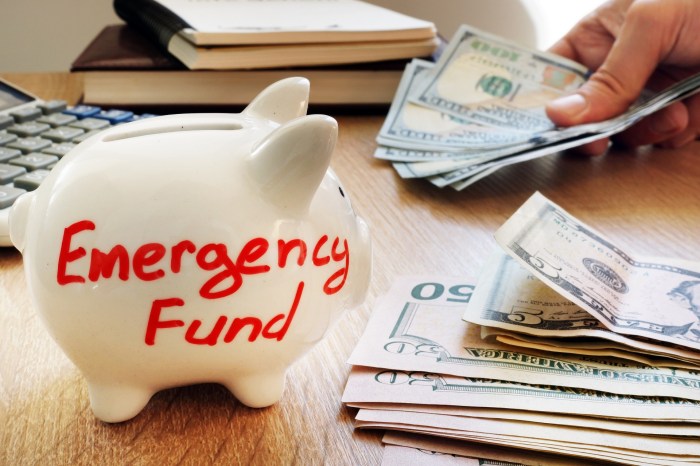When it comes to navigating the unpredictable waters of life, having an emergency fund is like having a financial safety net that can save you when unexpected expenses arise. In this piece, we’ll dive into the importance of emergency funds, how to build one, when to use it, and how it differs from other types of savings. So, buckle up and let’s explore the world of emergency funds in style!
Now, let’s get down to business and break down everything you need to know about emergency funds, from why they’re crucial to the nitty-gritty of building and using them.
Importance of Emergency Fund
Having an emergency fund is crucial for financial security as it provides a safety net in times of unexpected expenses or loss of income. It helps individuals avoid going into debt or making hasty financial decisions during challenging times.
Examples of Unexpected Situations
- Medical emergencies that require costly treatments not covered by insurance.
- Car repairs or breakdowns that are essential for daily transportation.
- Sudden job loss or reduction in income due to unforeseen circumstances.
Recommended Amount to Save
Financial experts recommend saving at least 3 to 6 months’ worth of expenses in an emergency fund. This amount can vary based on individual circumstances, such as job stability and overall financial health.
Building an Emergency Fund
Building an emergency fund is crucial for financial stability and peace of mind. Here are some strategies to help you start building your emergency fund:
Setting Savings Goals
- Establish a realistic target amount to save for emergencies, such as 3 to 6 months’ worth of expenses.
- Break down your goal into smaller, manageable milestones to track your progress.
- Automate your savings by setting up regular transfers from your checking account to your emergency fund.
Best Practices for Where to Keep Your Emergency Fund Money
- Choose a separate savings account specifically designated for your emergency fund to avoid spending it on non-urgent expenses.
- Consider keeping your emergency fund in a liquid account that allows easy access to the funds, such as a traditional savings account or a money market account.
- Ensure that your emergency fund is in a secure financial institution that is FDIC-insured for protection.
Difference Between Regular Savings Account and High-Yield Savings Account
- A regular savings account typically offers lower interest rates compared to a high-yield savings account.
- High-yield savings accounts provide higher interest rates, allowing your emergency fund to grow faster over time.
- While high-yield savings accounts may have certain limitations or requirements, they are a great option for maximizing the growth of your emergency fund.
Using an Emergency Fund
In times of unexpected financial strain, it is crucial to know when and how to utilize your emergency fund effectively. Let’s dive into the details of when it is appropriate to tap into your emergency savings and why replenishing it is essential.
When to Use Funds from Your Emergency Fund
- Medical Emergencies: Unforeseen medical expenses not covered by insurance can quickly deplete your savings.
- Car Repairs: Unexpected repair costs for your vehicle can put a dent in your budget.
- Job Loss: In the event of sudden unemployment, your emergency fund can cover essential expenses until you find a new job.
- Home Repairs: Major repairs like a leaky roof or a broken furnace can be costly and necessitate using your emergency savings.
Importance of Replenishing Your Emergency Fund
After utilizing your emergency fund, it is crucial to prioritize replenishing it to ensure you are prepared for future financial setbacks. Failing to replenish your emergency fund can leave you vulnerable to additional financial stress in the future.
Emergency Fund vs. Other Savings

When it comes to saving money, it’s important to understand the difference between an emergency fund and other types of savings. While both serve as financial cushions, they have distinct purposes and should be managed differently.
An emergency fund is specifically set aside to cover unexpected expenses or financial emergencies, such as medical bills, car repairs, or job loss. It acts as a safety net to protect you from going into debt or dipping into long-term savings like retirement accounts. On the other hand, regular savings are typically used for planned expenses or goals, such as vacations, home renovations, or buying a new car.
Retirement Savings
Retirement savings are focused on long-term financial security during your retirement years. These accounts, such as 401(k) or IRAs, are meant to grow over time through investments and compound interest. Unlike an emergency fund, tapping into retirement savings early can result in penalties and taxes, making it less ideal for short-term financial needs.
Other Types of Savings Accounts
Other savings accounts, like a vacation fund or a down payment fund, are earmarked for specific goals or purchases. While these accounts are important for achieving your financial dreams, they should be separate from your emergency fund. Mixing these savings goals can blur the lines between what is truly essential and what is discretionary.
Managing Multiple Savings Goals
To effectively manage multiple savings goals, it’s crucial to prioritize and allocate your funds accordingly. Start by building up your emergency fund to cover at least three to six months’ worth of living expenses. Once you have a solid emergency fund in place, you can focus on contributing to other savings goals, such as retirement, vacations, or major purchases. Consider automating your savings by setting up separate accounts or direct deposits to ensure you stay on track with each goal.
